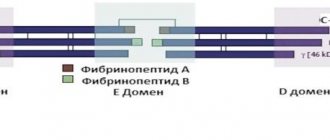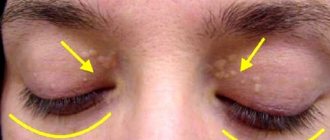A blood sample test for fibrinogen in plasma is used to assess the risk of thrombosis, as well as to identify abnormalities associated with this process. In addition to its function of stopping bleeding, protein is involved in the following body processes:
- increases the rate of healing of injured areas of tissue and integument;
- helps dissolve blood clots during the regeneration process;
- enlarges blood vessels and strengthens their walls, inhibits inflammation.
The study is most often prescribed before operations and interventions in order to determine the level of potential danger of sudden bleeding, if bleeding or thrombosis is suspected, and is also mandatory for all pregnant women. Less often they will be sent for research in the following cases:
- liver disease and kidney failure;
- vascular and heart diseases;
- defective blood clotting;
- the presence of inflammatory processes.
You can take the test in any clinic - this is a standard and common analysis, the cost of performing it in our laboratory can be found in the price section of the website.
Detailed description of the study
Fibrinogen, or factor I, is a plasma protein that is produced in the liver and plays an important role in the blood clotting process (hemostasis). Through various interactions, it plays an important role in stopping bleeding.
Fibrinogen is able to dissolve in plasma and serves as a precursor to the insoluble protein fibrin. The process of converting fibrinogen into fibrin, as well as the adhesion (aggregation) of platelets, is carried out with the help of three main enzymes that regulate hemostasis - thrombin, plasmin and factor XIIIa.
As a result, a blood clot is formed, consisting of fibrin strands and an accumulation of platelets. This helps stop bleeding effectively. The fibrin clot also activates the fibrinolytic system. This maintains a balance between blood clotting and protection against blood clots.
The amount of fibrinogen in the body may vary among individuals depending on age and gender. A physiological increase in the concentration of this protein is observed in pregnant women. Its level may also increase with age.
Pathological conditions that change the fibrinogen content in the body are divided into congenital and acquired. The first group of diseases is associated with mutations in genes. Some of them lead to fibrinogen deficiency in the blood, others increase its level. The presence of single mutations in the genes encoding the formation of this protein may not have any symptoms, but increases the risk of thrombosis with unfavorable concomitant factors.
Acquired diseases in which fibrinogen concentration increases primarily include infectious or other diseases accompanied by inflammation. Among them one can also note diabetes mellitus and obesity. Injuries and burns increase fibrinogen production, which is necessary to stop bleeding. An increased content of this protein is observed during pregnancy, as well as when taking estrogen hormones.
A decrease in fibrinogen levels is caused by a violation of its formation in the liver or accelerated destruction in the blood (fibrinolysis). However, in most pathological conditions (acute and chronic inflammation, trauma, burns, surgical interventions), this indicator becomes higher than normal.
Determining the amount of fibrinogen in plasma is necessary in order to assess blood clotting ability and, if necessary, carry out treatment to normalize hemostasis.
Fibrinogen is a protein produced in the liver and converted into insoluble fibrin, the basis of the clot during blood clotting.
Synonyms Russian
Factor I (first) of the plasma coagulation system.
English synonyms
Fibrinogen Activity and Fibrinogen Antigen Assays, Factor I, Fibrinogen Activity, Functional Fibrinogen, Fibrinogen Antigen.
Research method
Side scatter detection method, end point percentage determination.
Units
G/L (grams per liter).
What biomaterial can be used for research?
Venous blood.
How to properly prepare for research?
- Do not eat for 12 hours before the test.
- Avoid physical and emotional stress 30 minutes before the test.
- Do not smoke for 30 minutes before the test.
General information about the study
According to the international nomenclature, fibrinogen is factor I (first) of the blood plasma coagulation system. It is produced by the liver and released into the blood along with several other substances that affect blood clotting.
If a blood vessel or tissue is damaged, the body begins hemostasis, or blood clotting, resulting in the appearance of a blood clot (thrombus), which helps slow and then stop bleeding. This process produces strands of protein called fibrin. They intertwine, forming a fibrin mesh, which, together with platelets, contributes to the formation of a blood clot, which remains at the site of damage to the vessel until it is completely healed.
Given a sufficient number of platelets, each of the coagulation factors must act correctly to ensure the formation of a stable blood clot. Insufficient amounts or improper interaction of these factors can lead to bleeding or thrombosis.
Fibrinogen analysis is necessary in preoperative examination, prenatal diagnosis, and for inflammatory and cardiovascular diseases.
Fibrinogen is also one of the blood factors known as rheumatic tests. Levels of fibrinogen and other rheumatic factors rise sharply in the blood when there is inflammation or tissue damage.
The level of fibrinogen in the blood increases during acute inflammatory diseases, as well as during tissue death. In other cases, it can mean acute infectious and inflammatory diseases, strokes, myocardial infarction, hypothyroidism, amyloidosis, pneumonia, and malignant tumors. The reason for the increase in fibrinogen levels is previous operations, burns, or the patient taking estrogens or oral contraceptives.
It is worth noting that treatment for elevated fibrinogen levels may not be necessary in two cases: during pregnancy and the inflammatory process. Then the level of fibrinogen in the blood returns to normal on its own when the body’s condition stabilizes.
What is the research used for?
To assess the body's ability to form blood clots and identify associated disorders, such as hereditary afibrinohemia or hypofibrinohemia, chronic liver disease, exhaustion of the body, inflammatory process.
When is the study scheduled?
- In case of bleeding or thrombotic episode.
- When studying activated partial thromboplastin time (aPTT) or thrombin time (TT).
- In case of progressive liver disease.
What do the results mean?
Reference values
| Reference values |
| 1.8 - 3.5 g/l |
| Week of pregnancy | Reference values |
| 1-13th | 2.12 - 4.33 g/l |
| 13-21st | 2.9 - 5.3 g/l |
| 21st-29th | 3 - 5.7 g/l |
| 29-35th | 3.2 - 5.7 g/l |
| 35-42nd | 3.5 - 6.5 g/l |
Fibrinogen is an acute phase protein of inflammation. This means that the concentration of fibrinogen can increase sharply in any condition caused by inflammatory processes or tissue damage. Elevated fibrinogen alone does not provide the doctor with information about the cause of this change. Usually it is temporary and the level of fibrinogen in the patient's blood returns to normal after the cessation of exposure to the following factors.
Fibrinogen levels increase in the following cases:
- if there are malignant tumors in the body,
- with myocardial infarction,
- for burns,
- after undergoing surgery,
- for hypothyroidism,
- for acute inflammatory and infectious diseases (influenza, tuberculosis),
- in the first days after a stroke,
- with amyloidosis,
- with pneumonia,
- as a result of taking estrogens and oral contraceptives.
Factors that lower fibrinogen levels:
- DIC syndrome (in dynamics),
- liver diseases (hepatitis, cirrhosis),
- toxicosis,
- lack of vitamin C and B12,
- amniotic fluid embolism (in newborns),
- chronic myeloid leukemia,
- polycythemia,
- snake venom poisoning.
What can influence the result?
- A low level of fibrinogen occurs as a result of transfusion of a large amount of blood to the patient.
- Some drugs lower fibrinogen levels: anabolic steroids, phenobarbital, streptokinase, urokinase, and valproic acid.
Complexes with this research
Extended coagulogram Extended study of the functional state of hemostasis 4,150 ₽ Composition
Coagulogram Study of the functional state of hemostasis 2,020 ₽ Composition
Female infertility Analysis of women's reproductive health 16,210 RUR Composition
IN OTHER COMPLEXES
- Examination during pregnancy. 1st trimester 16,690 RUR
- Examination during pregnancy. 3rd trimester 9,620 RUR
- Preventative check-up RUB 11,960
- For those at risk of COVID-19 RUB 4,510
- Men's check-up No. 1 RUB 18,570
Fibrinogen
Fibrinogen is a protein produced in the liver and converted into insoluble fibrin, the basis of the clot during blood clotting.
Synonyms Russian
Factor I (first) of the plasma coagulation system.
English synonyms
Fibrinogen Activity and Fibrinogen Antigen Assays, Factor I, Fibrinogen Activity, Functional Fibrinogen, Fibrinogen Antigen.
Research method
Side scatter detection method, end point percentage determination.
Units
G/L (grams per liter).
What biomaterial can be used for research?
Venous blood.
How to properly prepare for research?
- Do not eat for 12 hours before the test.
- Avoid physical and emotional stress 30 minutes before the test.
- Do not smoke for 30 minutes before donating blood.
General information about the study
According to the international nomenclature, fibrinogen is factor I (first) of the blood plasma coagulation system. It is produced by the liver and released into the blood along with several other substances that affect blood clotting.
If a blood vessel or tissue is damaged, the body begins hemostasis, or blood clotting, resulting in the appearance of a blood clot (thrombus), which helps slow and then stop bleeding. This process produces strands of protein called fibrin. They intertwine, forming a fibrin mesh, which, together with platelets, contributes to the formation of a blood clot, which remains at the site of damage to the vessel until it is completely healed.
Given a sufficient number of platelets, each of the coagulation factors must act correctly to ensure the formation of a stable blood clot. Insufficient amounts or improper interaction of these factors can lead to bleeding or thrombosis.
Fibrinogen analysis is necessary in preoperative examination, prenatal diagnosis, and for inflammatory and cardiovascular diseases.
Fibrinogen is also one of the blood factors known as rheumatic tests. Levels of fibrinogen and other rheumatic factors rise sharply in the blood when there is inflammation or tissue damage.
The level of fibrinogen in the blood increases during acute inflammatory diseases, as well as during tissue death. In other cases, it can mean acute infectious and inflammatory diseases, strokes, myocardial infarction, hypothyroidism, amyloidosis, pneumonia, and malignant tumors. The reason for the increase in fibrinogen levels is previous operations, burns, or the patient taking estrogens or oral contraceptives.
It is worth noting that treatment for elevated fibrinogen levels may not be necessary in two cases: during pregnancy and the inflammatory process. Then the level of fibrinogen in the blood returns to normal on its own when the body’s condition stabilizes.
What is the research used for?
To assess the body's ability to form blood clots and identify associated disorders, such as hereditary afibrinohemia or hypofibrinohemia, chronic liver disease, exhaustion of the body, inflammatory process.
When is the study scheduled?
- In case of bleeding or thrombotic episode.
- When studying activated partial thromboplastin time (aPTT) or thrombin time (TT).
- In case of progressive liver disease.
What do the results mean?
Reference values
| Reference values |
| 1.8 - 3.5 g/l |
| Week of pregnancy | Reference values |
| 1-13th | 2.12 - 4.33 g/l |
| 13-21st | 2.9 - 5.3 g/l |
| 21st-29th | 3 - 5.7 g/l |
| 29-35th | 3.2 - 5.7 g/l |
| 35-42nd | 3.5 - 6.5 g/l |
Fibrinogen is an acute phase protein of inflammation. This means that the concentration of fibrinogen can increase sharply in any condition caused by inflammatory processes or tissue damage. Elevated fibrinogen alone does not provide the doctor with information about the cause of this change. Usually it is temporary and the level of fibrinogen in the patient's blood returns to normal after the cessation of exposure to the following factors.
Fibrinogen levels increase in the following cases:
- if there are malignant tumors in the body,
- with myocardial infarction,
- for burns,
- after undergoing surgery,
- for hypothyroidism,
- for acute inflammatory and infectious diseases (influenza, tuberculosis),
- in the first days after a stroke,
- with amyloidosis,
- with pneumonia,
- as a result of taking estrogens and oral contraceptives.
Factors that lower fibrinogen levels:
- DIC syndrome (in dynamics),
- liver diseases (hepatitis, cirrhosis),
- toxicosis,
- lack of vitamin C and B12,
- amniotic fluid embolism (in newborns),
- chronic myeloid leukemia,
- polycythemia,
- snake venom poisoning.
What can influence the result?
- A low level of fibrinogen occurs as a result of transfusion of a large amount of blood to the patient.
- Some drugs lower fibrinogen levels: anabolic steroids, phenobarbital, streptokinase, urokinase, and valproic acid.
Important Notes
- Dysfibrinogenemia (fibrinogen deficiency) is a rare clotting disorder caused by mutations in the gene that controls fibrinogen production in the liver. It can lead to venous blood clots or, rarely, bleeding. Patients with dysfibrinohemia may have poor blood clotting.
- A fibrinogen level that exceeds the norm may indicate an increased risk of cardiovascular diseases, then it is necessary to take measures to normalize it, this may include the use of medications and medical procedures to reduce the level of cholesterol in the blood.
- Some studies suggest that taking medications containing omega-3 and omega-6 fatty acids reduces fibrinogen levels in the blood.
Also recommended
- Activated partial thromboplastin time (aPTT)
- Coagulogram No. 1 (prothrombin (according to Quick), INR
- Antithrombin III
- Detection of the G(-455)A mutation in the FGB gene
Who orders the study?
Therapist, cardiologist, surgeon, gynecologist, hematologist.
Normal protein levels
In healthy patients, fibrinogen levels depend on age:
- adult women and men – from 2 to 4 g/l;
- newborns – from 1.25 to 3 g/l;
- pregnant women - from 6 to 7 g/l.
To determine the level, venous blood is taken. Tests are taken 12 hours after the last meal; 2 hours before the procedure, you must avoid any physical activity. The patient should not smoke 40 minutes before the appointment.
During pregnancy, the amount of fibrinogen gradually changes:
- in the first 3 months – 2.98 g/l, reduced results are associated with toxicosis;
- in the second trimester – about 3.1 g/l;
- last quarter – 4.95-6 g/l.
If the protein exceeds the specified results, then the following may occur:
- infertility;
- premature placental abruption;
- thrombosis in vessels located in the umbilical cord;
- gestosis, early miscarriage;
- frozen pregnancy, premature labor;
- thrombosis or thrombophlebitis.
To timely determine developing abnormalities, pregnant women undergo a coagulogram several times throughout the entire period. Primary samples show information about the volume of fibrinogen contained, and final samples show information about the risks of developing thrombosis and the body’s readiness for labor.
How to prepare for analysis and get results
For the study, blood is taken from a vein in the morning, on an empty stomach. It is advisable not to drink alcohol the day before or eat food at least 8 hours before taking the test, not to smoke 2 hours before and to avoid physical activity. It is not recommended to take a test for fibrinogen levels during an infectious disease, during bleeding (for women - during menstruation), or within a month after a blood transfusion.
The results of the analysis can be affected by medications - heparin, antioxidants, oral contraceptives and anabolic steroids. If it is not possible to cancel them 2-3 days before the test, be sure to notify our clinic employee. The result of the sample will be ready 1-2 days after the test.
Increased protein
A large amount of fibrinogen warns of a hidden inflammatory process and the danger of blood clots. Pathological deviation indicates the presence of:
- rheumatism, nephrotic syndrome;
- heart attack, infections;
- diabetes mellitus, pneumonia;
- hepatitis, DIC syndrome, tuberculosis;
- cancer, trauma, burns.
The increase in fibrinogen volume in pregnant women is explained by the physiological norm. Sometimes an unusual increase in protein is associated with age-related changes and the use of oral contraceptives. If a deviation is detected, the patient must be sent for additional diagnostics to identify the root causes of the abnormal condition.
Blood plasma analysis for fibrinogen: reference norms and deviations
When receiving the results of any research, it is important to remember that they are not the only criterion by which the attending physician makes a diagnosis and prescribes treatment. Interpretation is carried out only by a specialist in combination with anamnesis data and the results of other tests.
Based on retail clinical studies, scientists have identified fibrinogen standards that are:
- for newborns and infants up to 1 year - 1.25-3 g/l;
- adult body (men and women) -2–4 g/l;
- 12-20 weeks of pregnancy - 2.9-5.3 g/l;
- 20-28 weeks of pregnancy - 3.0-5.7 g/l;
- 28-34 weeks of pregnancy - 3.2-5.7 g/l;
- 34-42 weeks of pregnancy -3.5-6.5 g/l.
The minimum level of plasma fibrinogen required for clot formation is 0.5 g/l. Elevated readings may indicate activity of the coagulation system or the occurrence of excessive blood clots, usually they occur with the following diseases:
- development of thrombohemorrhagic syndrome;
- obesity and development of diabetes mellitus;
- death of the heart muscle due to insufficient blood supply;
- pneumonia.
If the level is elevated, the doctor prescribes high-quality therapy to eliminate the underlying disease, as a result of which the protein will eventually drop to normal on its own. Fibrinogen can also be reduced with medications: thrombolytics, antiplatelet agents, anticoagulants; food also helps: fresh vegetables, seafood, cocoa and dark chocolate, red berries.
If fibrinogen is below normal, blood clotting slows down. Lack or complete absence of protein is a life-threatening condition that can be fatal. If there is not enough protein, the clot coagulates loosely and cannot stop the bleeding quickly enough. In the complete absence of fibrinogen, the blood does not clot at all, and any injury threatens to be fatal. The condition may be congenital or acquired as a result of one of the following diseases:
- intoxication of the body;
- thrombohemorrhagic syndrome;
- poisoning with toxic substances;
- excessive intake of Omega-3;
- hypovitaminosis of vitamins C and B12;
- taking steroid sex hormones, anabolic steroids, valproic acid.
Fibrinogen drops noticeably in vegetarians who have completely abandoned animal products, as well as when alcohol enters the bloodstream. If the level is reduced, the patient’s main task after the study is to promptly consult a doctor in order to prescribe the main treatment. Fibrinogen can be increased with medications: tranexam, etamsylate, vikasol and 6-aminohexanoic acid, and the diet can be enriched with foods that contain large amounts of protein.
Low protein
As the amount of fibrinogen decreases, the rate of blood clotting decreases and the risk of spontaneous bleeding increases. The root cause of the anomaly lies in congenital characteristics or individual diseases:
- due to DIC syndrome;
- congenital afibrinogenemia, hypofibrinogenemia;
- deficiency of ascorbic acid and cobalamin;
- treatment with anticoagulants;
- polycythemia, taking androgens or anabolic steroids, fish oil;
- toxicosis of pregnant women - early and late type;
- poisonous snake bites;
- liver cirrhosis;
- amniotic fluid embolism - a problem that occurs in infants.
A decrease in protein units occurs in vegetarians, during therapy with antioxidants, and moderate consumption of alcoholic beverages (with clearly adjusted dosages). When the level drops from 0.5 to 1 g/l, there is a risk of bleeding from the arteries and veins of the internal organs. The condition requires hospitalization and observation by medical personnel.










